Spaced Learning vs Mass Learning: A Psychology Lab Experiment
VerifiedAdded on 2023/06/04
|10
|2631
|451
AI Summary
This report seeks to address the debate between retaining mass learning or to switch over to distributed mode of learning. A research is conducted to verify or falsify the claims made by scholars. The report provides an overview of what spaced learning as a technique entails and on the basis of the reading of a selected list of essays. The report also includes a psychology lab experiment conducted to compare the effectiveness of spaced learning and mass learning.
Contribute Materials
Your contribution can guide someone’s learning journey. Share your
documents today.

Running head: PSYCHOLOGY LAB EXPERIMENT
Psychology Lab Experiment
Name of the Student
Name of the University
Author Note
Psychology Lab Experiment
Name of the Student
Name of the University
Author Note
Secure Best Marks with AI Grader
Need help grading? Try our AI Grader for instant feedback on your assignments.
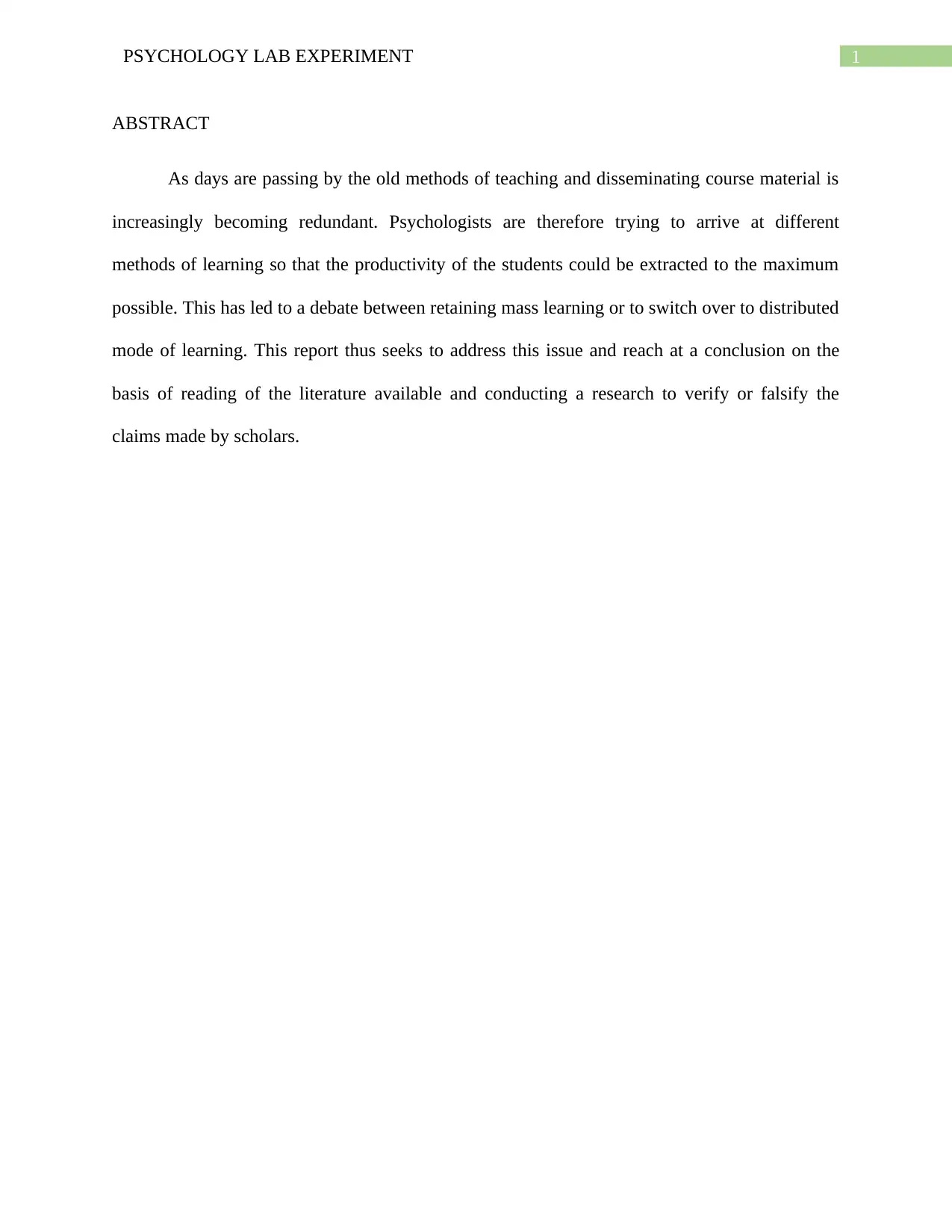
1PSYCHOLOGY LAB EXPERIMENT
ABSTRACT
As days are passing by the old methods of teaching and disseminating course material is
increasingly becoming redundant. Psychologists are therefore trying to arrive at different
methods of learning so that the productivity of the students could be extracted to the maximum
possible. This has led to a debate between retaining mass learning or to switch over to distributed
mode of learning. This report thus seeks to address this issue and reach at a conclusion on the
basis of reading of the literature available and conducting a research to verify or falsify the
claims made by scholars.
ABSTRACT
As days are passing by the old methods of teaching and disseminating course material is
increasingly becoming redundant. Psychologists are therefore trying to arrive at different
methods of learning so that the productivity of the students could be extracted to the maximum
possible. This has led to a debate between retaining mass learning or to switch over to distributed
mode of learning. This report thus seeks to address this issue and reach at a conclusion on the
basis of reading of the literature available and conducting a research to verify or falsify the
claims made by scholars.

2PSYCHOLOGY LAB EXPERIMENT
Introduction
With each passing day, the techniques being employed in educating the students are
increasingly becoming redundant and that calls for the application of newer methods of teaching
students. Gone are the days when it was considered the best technique to stuff the brains of
students with information, but in today’s world the stress is more on ensuring that the student is
being able to absorb and imbibe the course which they are supposed to be taught. This has led to
a debate between masses and distributed teaching practices. Naturally, this has necessitated the
need to divide the dissemination of course material in multiple sessions (Bernstein, 2000). This
report thus seeks to provide an overview of what spaced learning as a technique entails and on
the basis of the reading of a selected list of essays, a research shall be conducted. In the
following sections an account of the literature review and the findings of the report shall be
provided.
Literature Review
Shana K. Carpenter, Nicholas J. Cepeda, Doug Rohrer, Sean H. K. Kang and Harold
Pashler (2012) in their article provides an overview of the benefits that students shall be reaping
if they are made to study information related issues in fragmented sessions. This approach, as per
their views is a product of the findings and reports based on the latest researches conducted for
identifying the best methods of instruction and what could be the possible implications of it.
They have laid a great deal of emphasis on the method of teaching students over multiple
sessions, rather than in a single session, which they consider the best for enhancing the cognitive
skills and memory retention of a student. The nature of the study is deductive in nature as it
seeks to provide inferences and recommendations which reinstate the advantages of following a
Introduction
With each passing day, the techniques being employed in educating the students are
increasingly becoming redundant and that calls for the application of newer methods of teaching
students. Gone are the days when it was considered the best technique to stuff the brains of
students with information, but in today’s world the stress is more on ensuring that the student is
being able to absorb and imbibe the course which they are supposed to be taught. This has led to
a debate between masses and distributed teaching practices. Naturally, this has necessitated the
need to divide the dissemination of course material in multiple sessions (Bernstein, 2000). This
report thus seeks to provide an overview of what spaced learning as a technique entails and on
the basis of the reading of a selected list of essays, a research shall be conducted. In the
following sections an account of the literature review and the findings of the report shall be
provided.
Literature Review
Shana K. Carpenter, Nicholas J. Cepeda, Doug Rohrer, Sean H. K. Kang and Harold
Pashler (2012) in their article provides an overview of the benefits that students shall be reaping
if they are made to study information related issues in fragmented sessions. This approach, as per
their views is a product of the findings and reports based on the latest researches conducted for
identifying the best methods of instruction and what could be the possible implications of it.
They have laid a great deal of emphasis on the method of teaching students over multiple
sessions, rather than in a single session, which they consider the best for enhancing the cognitive
skills and memory retention of a student. The nature of the study is deductive in nature as it
seeks to provide inferences and recommendations which reinstate the advantages of following a
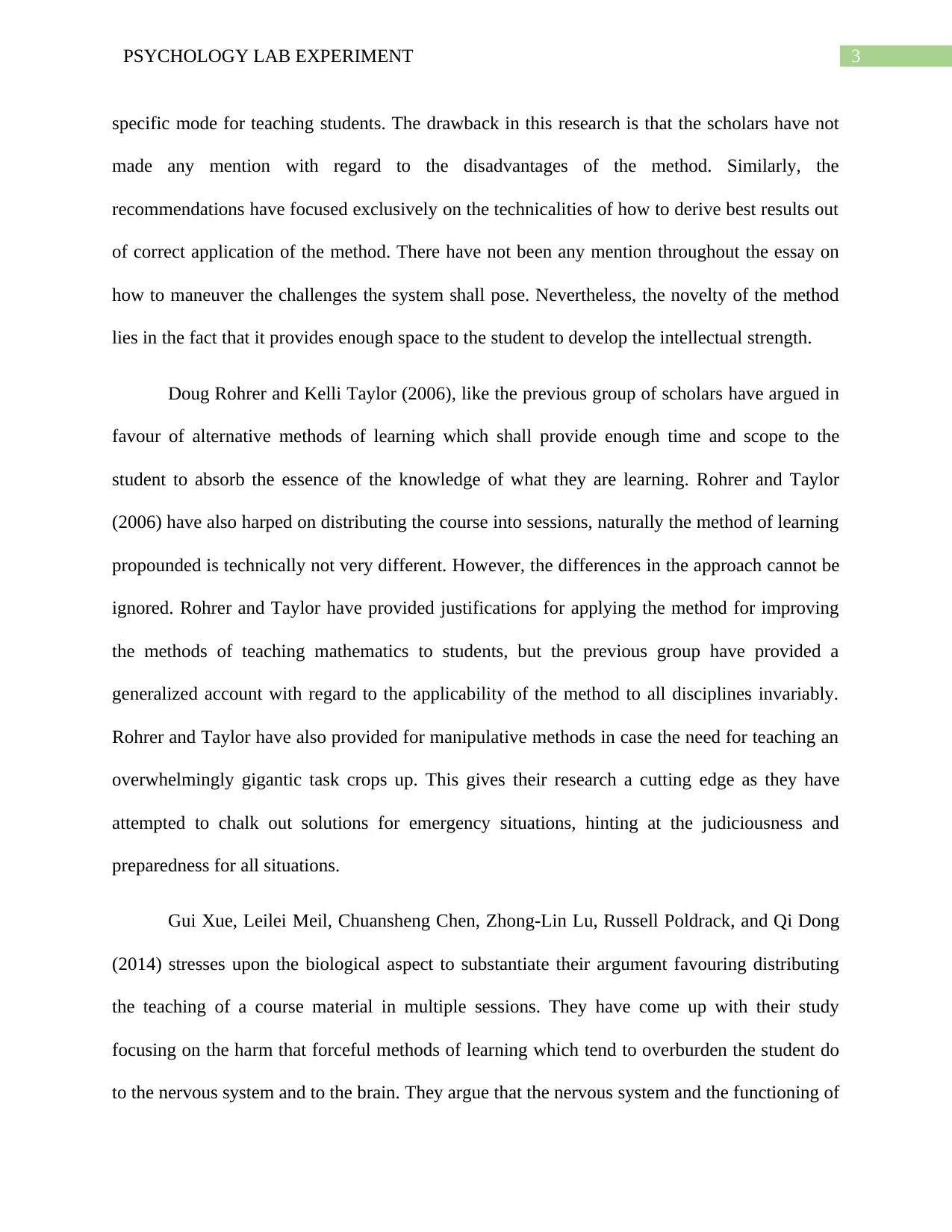
3PSYCHOLOGY LAB EXPERIMENT
specific mode for teaching students. The drawback in this research is that the scholars have not
made any mention with regard to the disadvantages of the method. Similarly, the
recommendations have focused exclusively on the technicalities of how to derive best results out
of correct application of the method. There have not been any mention throughout the essay on
how to maneuver the challenges the system shall pose. Nevertheless, the novelty of the method
lies in the fact that it provides enough space to the student to develop the intellectual strength.
Doug Rohrer and Kelli Taylor (2006), like the previous group of scholars have argued in
favour of alternative methods of learning which shall provide enough time and scope to the
student to absorb the essence of the knowledge of what they are learning. Rohrer and Taylor
(2006) have also harped on distributing the course into sessions, naturally the method of learning
propounded is technically not very different. However, the differences in the approach cannot be
ignored. Rohrer and Taylor have provided justifications for applying the method for improving
the methods of teaching mathematics to students, but the previous group have provided a
generalized account with regard to the applicability of the method to all disciplines invariably.
Rohrer and Taylor have also provided for manipulative methods in case the need for teaching an
overwhelmingly gigantic task crops up. This gives their research a cutting edge as they have
attempted to chalk out solutions for emergency situations, hinting at the judiciousness and
preparedness for all situations.
Gui Xue, Leilei Meil, Chuansheng Chen, Zhong-Lin Lu, Russell Poldrack, and Qi Dong
(2014) stresses upon the biological aspect to substantiate their argument favouring distributing
the teaching of a course material in multiple sessions. They have come up with their study
focusing on the harm that forceful methods of learning which tend to overburden the student do
to the nervous system and to the brain. They argue that the nervous system and the functioning of
specific mode for teaching students. The drawback in this research is that the scholars have not
made any mention with regard to the disadvantages of the method. Similarly, the
recommendations have focused exclusively on the technicalities of how to derive best results out
of correct application of the method. There have not been any mention throughout the essay on
how to maneuver the challenges the system shall pose. Nevertheless, the novelty of the method
lies in the fact that it provides enough space to the student to develop the intellectual strength.
Doug Rohrer and Kelli Taylor (2006), like the previous group of scholars have argued in
favour of alternative methods of learning which shall provide enough time and scope to the
student to absorb the essence of the knowledge of what they are learning. Rohrer and Taylor
(2006) have also harped on distributing the course into sessions, naturally the method of learning
propounded is technically not very different. However, the differences in the approach cannot be
ignored. Rohrer and Taylor have provided justifications for applying the method for improving
the methods of teaching mathematics to students, but the previous group have provided a
generalized account with regard to the applicability of the method to all disciplines invariably.
Rohrer and Taylor have also provided for manipulative methods in case the need for teaching an
overwhelmingly gigantic task crops up. This gives their research a cutting edge as they have
attempted to chalk out solutions for emergency situations, hinting at the judiciousness and
preparedness for all situations.
Gui Xue, Leilei Meil, Chuansheng Chen, Zhong-Lin Lu, Russell Poldrack, and Qi Dong
(2014) stresses upon the biological aspect to substantiate their argument favouring distributing
the teaching of a course material in multiple sessions. They have come up with their study
focusing on the harm that forceful methods of learning which tend to overburden the student do
to the nervous system and to the brain. They argue that the nervous system and the functioning of
Secure Best Marks with AI Grader
Need help grading? Try our AI Grader for instant feedback on your assignments.
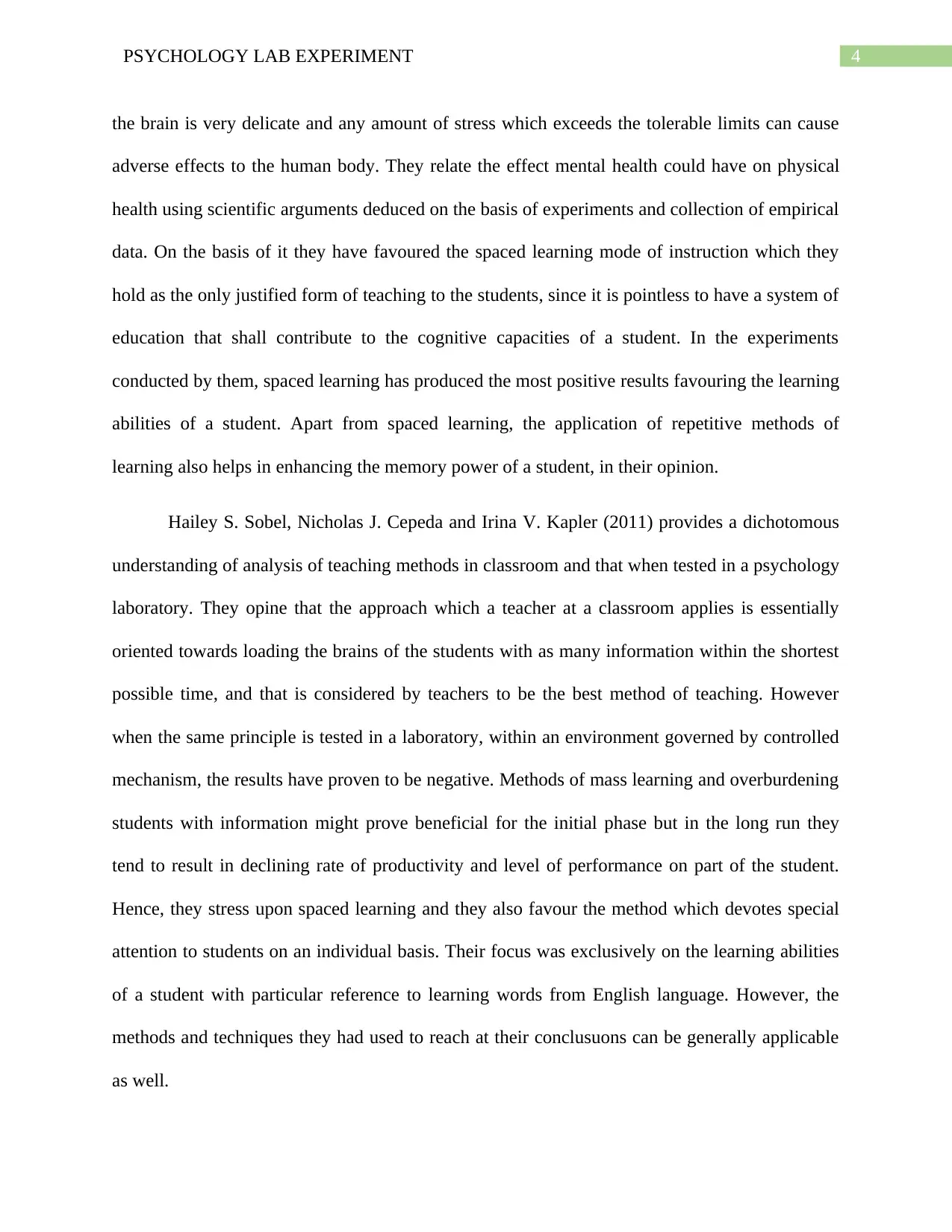
4PSYCHOLOGY LAB EXPERIMENT
the brain is very delicate and any amount of stress which exceeds the tolerable limits can cause
adverse effects to the human body. They relate the effect mental health could have on physical
health using scientific arguments deduced on the basis of experiments and collection of empirical
data. On the basis of it they have favoured the spaced learning mode of instruction which they
hold as the only justified form of teaching to the students, since it is pointless to have a system of
education that shall contribute to the cognitive capacities of a student. In the experiments
conducted by them, spaced learning has produced the most positive results favouring the learning
abilities of a student. Apart from spaced learning, the application of repetitive methods of
learning also helps in enhancing the memory power of a student, in their opinion.
Hailey S. Sobel, Nicholas J. Cepeda and Irina V. Kapler (2011) provides a dichotomous
understanding of analysis of teaching methods in classroom and that when tested in a psychology
laboratory. They opine that the approach which a teacher at a classroom applies is essentially
oriented towards loading the brains of the students with as many information within the shortest
possible time, and that is considered by teachers to be the best method of teaching. However
when the same principle is tested in a laboratory, within an environment governed by controlled
mechanism, the results have proven to be negative. Methods of mass learning and overburdening
students with information might prove beneficial for the initial phase but in the long run they
tend to result in declining rate of productivity and level of performance on part of the student.
Hence, they stress upon spaced learning and they also favour the method which devotes special
attention to students on an individual basis. Their focus was exclusively on the learning abilities
of a student with particular reference to learning words from English language. However, the
methods and techniques they had used to reach at their conclusuons can be generally applicable
as well.
the brain is very delicate and any amount of stress which exceeds the tolerable limits can cause
adverse effects to the human body. They relate the effect mental health could have on physical
health using scientific arguments deduced on the basis of experiments and collection of empirical
data. On the basis of it they have favoured the spaced learning mode of instruction which they
hold as the only justified form of teaching to the students, since it is pointless to have a system of
education that shall contribute to the cognitive capacities of a student. In the experiments
conducted by them, spaced learning has produced the most positive results favouring the learning
abilities of a student. Apart from spaced learning, the application of repetitive methods of
learning also helps in enhancing the memory power of a student, in their opinion.
Hailey S. Sobel, Nicholas J. Cepeda and Irina V. Kapler (2011) provides a dichotomous
understanding of analysis of teaching methods in classroom and that when tested in a psychology
laboratory. They opine that the approach which a teacher at a classroom applies is essentially
oriented towards loading the brains of the students with as many information within the shortest
possible time, and that is considered by teachers to be the best method of teaching. However
when the same principle is tested in a laboratory, within an environment governed by controlled
mechanism, the results have proven to be negative. Methods of mass learning and overburdening
students with information might prove beneficial for the initial phase but in the long run they
tend to result in declining rate of productivity and level of performance on part of the student.
Hence, they stress upon spaced learning and they also favour the method which devotes special
attention to students on an individual basis. Their focus was exclusively on the learning abilities
of a student with particular reference to learning words from English language. However, the
methods and techniques they had used to reach at their conclusuons can be generally applicable
as well.
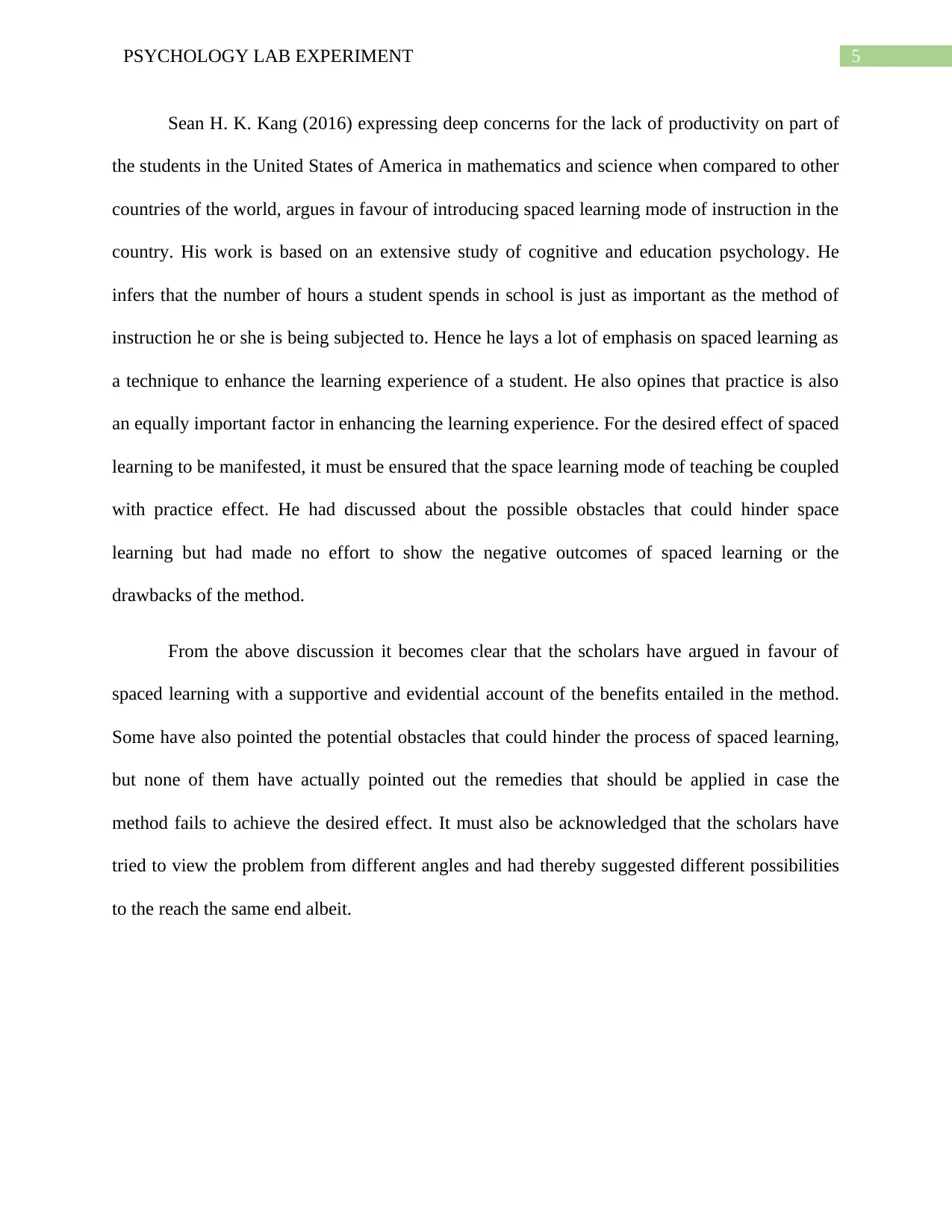
5PSYCHOLOGY LAB EXPERIMENT
Sean H. K. Kang (2016) expressing deep concerns for the lack of productivity on part of
the students in the United States of America in mathematics and science when compared to other
countries of the world, argues in favour of introducing spaced learning mode of instruction in the
country. His work is based on an extensive study of cognitive and education psychology. He
infers that the number of hours a student spends in school is just as important as the method of
instruction he or she is being subjected to. Hence he lays a lot of emphasis on spaced learning as
a technique to enhance the learning experience of a student. He also opines that practice is also
an equally important factor in enhancing the learning experience. For the desired effect of spaced
learning to be manifested, it must be ensured that the space learning mode of teaching be coupled
with practice effect. He had discussed about the possible obstacles that could hinder space
learning but had made no effort to show the negative outcomes of spaced learning or the
drawbacks of the method.
From the above discussion it becomes clear that the scholars have argued in favour of
spaced learning with a supportive and evidential account of the benefits entailed in the method.
Some have also pointed the potential obstacles that could hinder the process of spaced learning,
but none of them have actually pointed out the remedies that should be applied in case the
method fails to achieve the desired effect. It must also be acknowledged that the scholars have
tried to view the problem from different angles and had thereby suggested different possibilities
to the reach the same end albeit.
Sean H. K. Kang (2016) expressing deep concerns for the lack of productivity on part of
the students in the United States of America in mathematics and science when compared to other
countries of the world, argues in favour of introducing spaced learning mode of instruction in the
country. His work is based on an extensive study of cognitive and education psychology. He
infers that the number of hours a student spends in school is just as important as the method of
instruction he or she is being subjected to. Hence he lays a lot of emphasis on spaced learning as
a technique to enhance the learning experience of a student. He also opines that practice is also
an equally important factor in enhancing the learning experience. For the desired effect of spaced
learning to be manifested, it must be ensured that the space learning mode of teaching be coupled
with practice effect. He had discussed about the possible obstacles that could hinder space
learning but had made no effort to show the negative outcomes of spaced learning or the
drawbacks of the method.
From the above discussion it becomes clear that the scholars have argued in favour of
spaced learning with a supportive and evidential account of the benefits entailed in the method.
Some have also pointed the potential obstacles that could hinder the process of spaced learning,
but none of them have actually pointed out the remedies that should be applied in case the
method fails to achieve the desired effect. It must also be acknowledged that the scholars have
tried to view the problem from different angles and had thereby suggested different possibilities
to the reach the same end albeit.
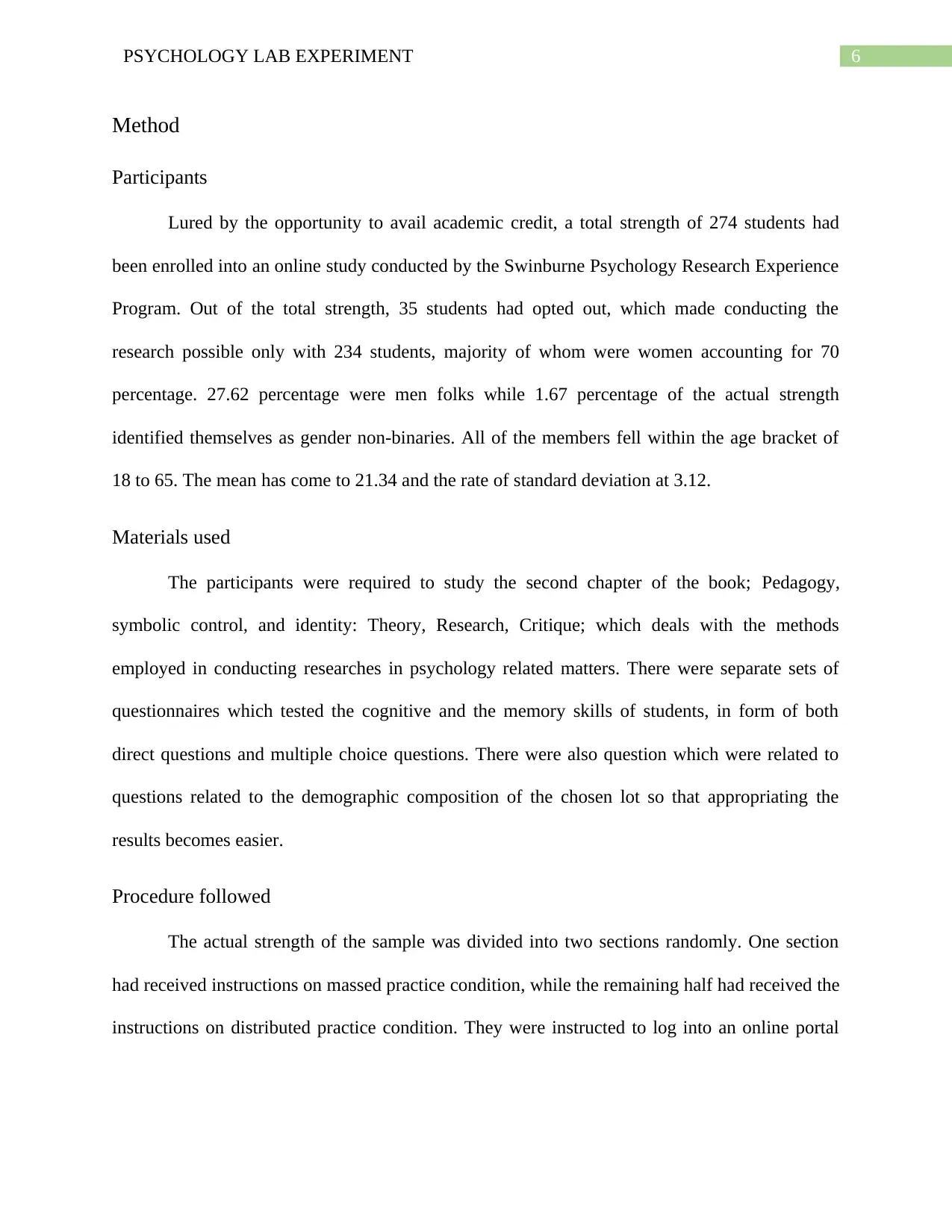
6PSYCHOLOGY LAB EXPERIMENT
Method
Participants
Lured by the opportunity to avail academic credit, a total strength of 274 students had
been enrolled into an online study conducted by the Swinburne Psychology Research Experience
Program. Out of the total strength, 35 students had opted out, which made conducting the
research possible only with 234 students, majority of whom were women accounting for 70
percentage. 27.62 percentage were men folks while 1.67 percentage of the actual strength
identified themselves as gender non-binaries. All of the members fell within the age bracket of
18 to 65. The mean has come to 21.34 and the rate of standard deviation at 3.12.
Materials used
The participants were required to study the second chapter of the book; Pedagogy,
symbolic control, and identity: Theory, Research, Critique; which deals with the methods
employed in conducting researches in psychology related matters. There were separate sets of
questionnaires which tested the cognitive and the memory skills of students, in form of both
direct questions and multiple choice questions. There were also question which were related to
questions related to the demographic composition of the chosen lot so that appropriating the
results becomes easier.
Procedure followed
The actual strength of the sample was divided into two sections randomly. One section
had received instructions on massed practice condition, while the remaining half had received the
instructions on distributed practice condition. They were instructed to log into an online portal
Method
Participants
Lured by the opportunity to avail academic credit, a total strength of 274 students had
been enrolled into an online study conducted by the Swinburne Psychology Research Experience
Program. Out of the total strength, 35 students had opted out, which made conducting the
research possible only with 234 students, majority of whom were women accounting for 70
percentage. 27.62 percentage were men folks while 1.67 percentage of the actual strength
identified themselves as gender non-binaries. All of the members fell within the age bracket of
18 to 65. The mean has come to 21.34 and the rate of standard deviation at 3.12.
Materials used
The participants were required to study the second chapter of the book; Pedagogy,
symbolic control, and identity: Theory, Research, Critique; which deals with the methods
employed in conducting researches in psychology related matters. There were separate sets of
questionnaires which tested the cognitive and the memory skills of students, in form of both
direct questions and multiple choice questions. There were also question which were related to
questions related to the demographic composition of the chosen lot so that appropriating the
results becomes easier.
Procedure followed
The actual strength of the sample was divided into two sections randomly. One section
had received instructions on massed practice condition, while the remaining half had received the
instructions on distributed practice condition. They were instructed to log into an online portal
Paraphrase This Document
Need a fresh take? Get an instant paraphrase of this document with our AI Paraphraser
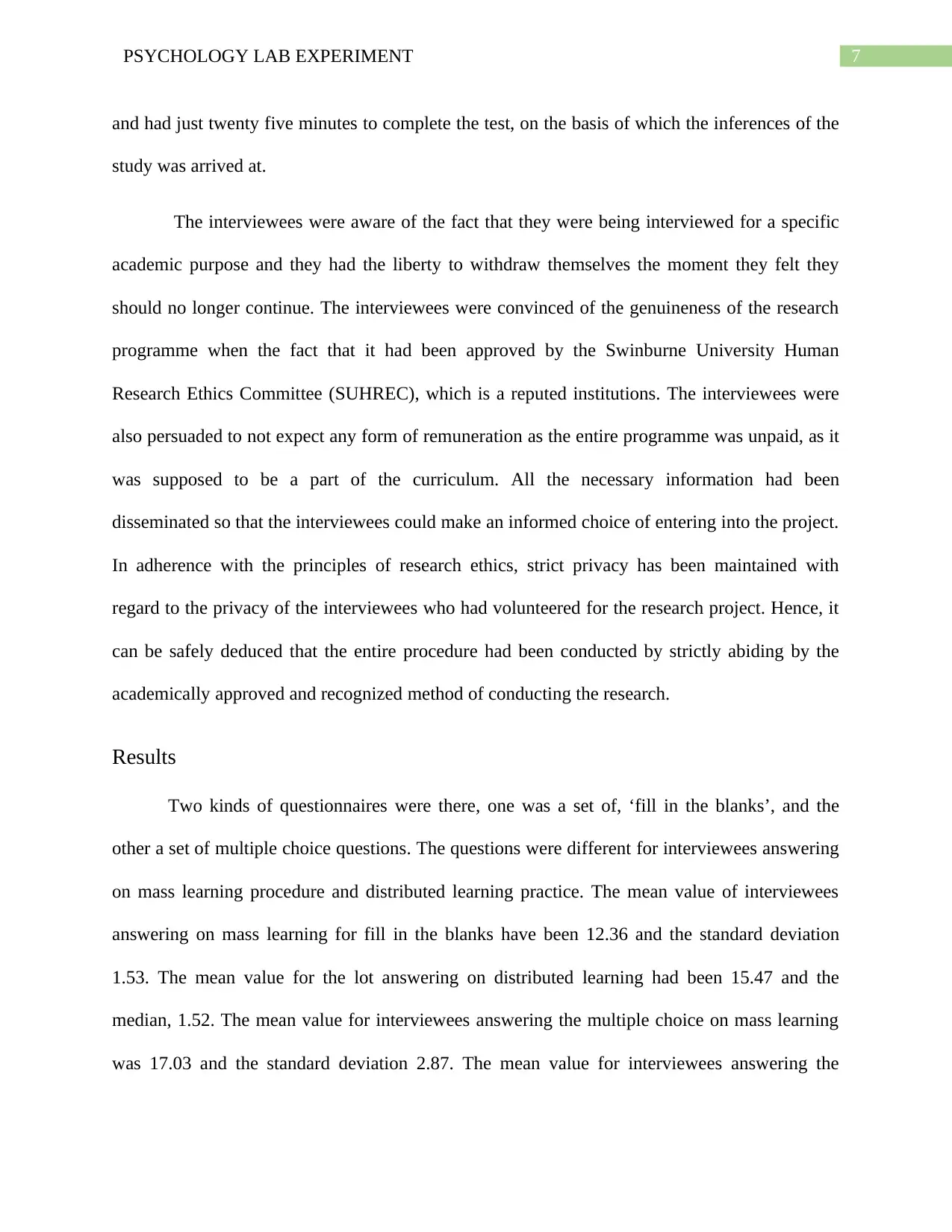
7PSYCHOLOGY LAB EXPERIMENT
and had just twenty five minutes to complete the test, on the basis of which the inferences of the
study was arrived at.
The interviewees were aware of the fact that they were being interviewed for a specific
academic purpose and they had the liberty to withdraw themselves the moment they felt they
should no longer continue. The interviewees were convinced of the genuineness of the research
programme when the fact that it had been approved by the Swinburne University Human
Research Ethics Committee (SUHREC), which is a reputed institutions. The interviewees were
also persuaded to not expect any form of remuneration as the entire programme was unpaid, as it
was supposed to be a part of the curriculum. All the necessary information had been
disseminated so that the interviewees could make an informed choice of entering into the project.
In adherence with the principles of research ethics, strict privacy has been maintained with
regard to the privacy of the interviewees who had volunteered for the research project. Hence, it
can be safely deduced that the entire procedure had been conducted by strictly abiding by the
academically approved and recognized method of conducting the research.
Results
Two kinds of questionnaires were there, one was a set of, ‘fill in the blanks’, and the
other a set of multiple choice questions. The questions were different for interviewees answering
on mass learning procedure and distributed learning practice. The mean value of interviewees
answering on mass learning for fill in the blanks have been 12.36 and the standard deviation
1.53. The mean value for the lot answering on distributed learning had been 15.47 and the
median, 1.52. The mean value for interviewees answering the multiple choice on mass learning
was 17.03 and the standard deviation 2.87. The mean value for interviewees answering the
and had just twenty five minutes to complete the test, on the basis of which the inferences of the
study was arrived at.
The interviewees were aware of the fact that they were being interviewed for a specific
academic purpose and they had the liberty to withdraw themselves the moment they felt they
should no longer continue. The interviewees were convinced of the genuineness of the research
programme when the fact that it had been approved by the Swinburne University Human
Research Ethics Committee (SUHREC), which is a reputed institutions. The interviewees were
also persuaded to not expect any form of remuneration as the entire programme was unpaid, as it
was supposed to be a part of the curriculum. All the necessary information had been
disseminated so that the interviewees could make an informed choice of entering into the project.
In adherence with the principles of research ethics, strict privacy has been maintained with
regard to the privacy of the interviewees who had volunteered for the research project. Hence, it
can be safely deduced that the entire procedure had been conducted by strictly abiding by the
academically approved and recognized method of conducting the research.
Results
Two kinds of questionnaires were there, one was a set of, ‘fill in the blanks’, and the
other a set of multiple choice questions. The questions were different for interviewees answering
on mass learning procedure and distributed learning practice. The mean value of interviewees
answering on mass learning for fill in the blanks have been 12.36 and the standard deviation
1.53. The mean value for the lot answering on distributed learning had been 15.47 and the
median, 1.52. The mean value for interviewees answering the multiple choice on mass learning
was 17.03 and the standard deviation 2.87. The mean value for interviewees answering the

8PSYCHOLOGY LAB EXPERIMENT
multiple choice on distributed learning was 16.59 and the standard deviation 1.45. In the next
section the results shall be analyzed.
Discussion
The total number of correct responses generated from the interviewees answering for
mass learning in the fill in the blanks have been 741.60 and for multiple choice have been
1038.83. The total number of correct responses generated from the interviewees answering for
distributed learning in the fill in the blanks have been 928.20 and for multiple choice had been
962.22. The total number of correct responses for candidates answering for mass learning have
been 1780.45 and that for the interviewees answering for distributed learning, 1891.02. This
leads us to the analysis that distributed learning is a better and more feasible option to teach
students, as the results have been better for the candidates answering for distributed learning.
Though the number of candidates appearing for distributed learning had been less, 118, while for
mass learning it had been more, 121, the former had scored better.
Conclusion
Based on the appropriation reached at by the research data, it becomes very clear that
distributed learning is a more effective method of learning. Despite having less number of
candidates the candidates appearing for distributed learning had scored more. The margin might
not be too large, but the results are nevertheless in favour of distributed learning. This matching
of the results of the mathematical data and that of the conclusion of the literature review, both
being in support of distribute learning shows that Distributed learning is a better option.
multiple choice on distributed learning was 16.59 and the standard deviation 1.45. In the next
section the results shall be analyzed.
Discussion
The total number of correct responses generated from the interviewees answering for
mass learning in the fill in the blanks have been 741.60 and for multiple choice have been
1038.83. The total number of correct responses generated from the interviewees answering for
distributed learning in the fill in the blanks have been 928.20 and for multiple choice had been
962.22. The total number of correct responses for candidates answering for mass learning have
been 1780.45 and that for the interviewees answering for distributed learning, 1891.02. This
leads us to the analysis that distributed learning is a better and more feasible option to teach
students, as the results have been better for the candidates answering for distributed learning.
Though the number of candidates appearing for distributed learning had been less, 118, while for
mass learning it had been more, 121, the former had scored better.
Conclusion
Based on the appropriation reached at by the research data, it becomes very clear that
distributed learning is a more effective method of learning. Despite having less number of
candidates the candidates appearing for distributed learning had scored more. The margin might
not be too large, but the results are nevertheless in favour of distributed learning. This matching
of the results of the mathematical data and that of the conclusion of the literature review, both
being in support of distribute learning shows that Distributed learning is a better option.
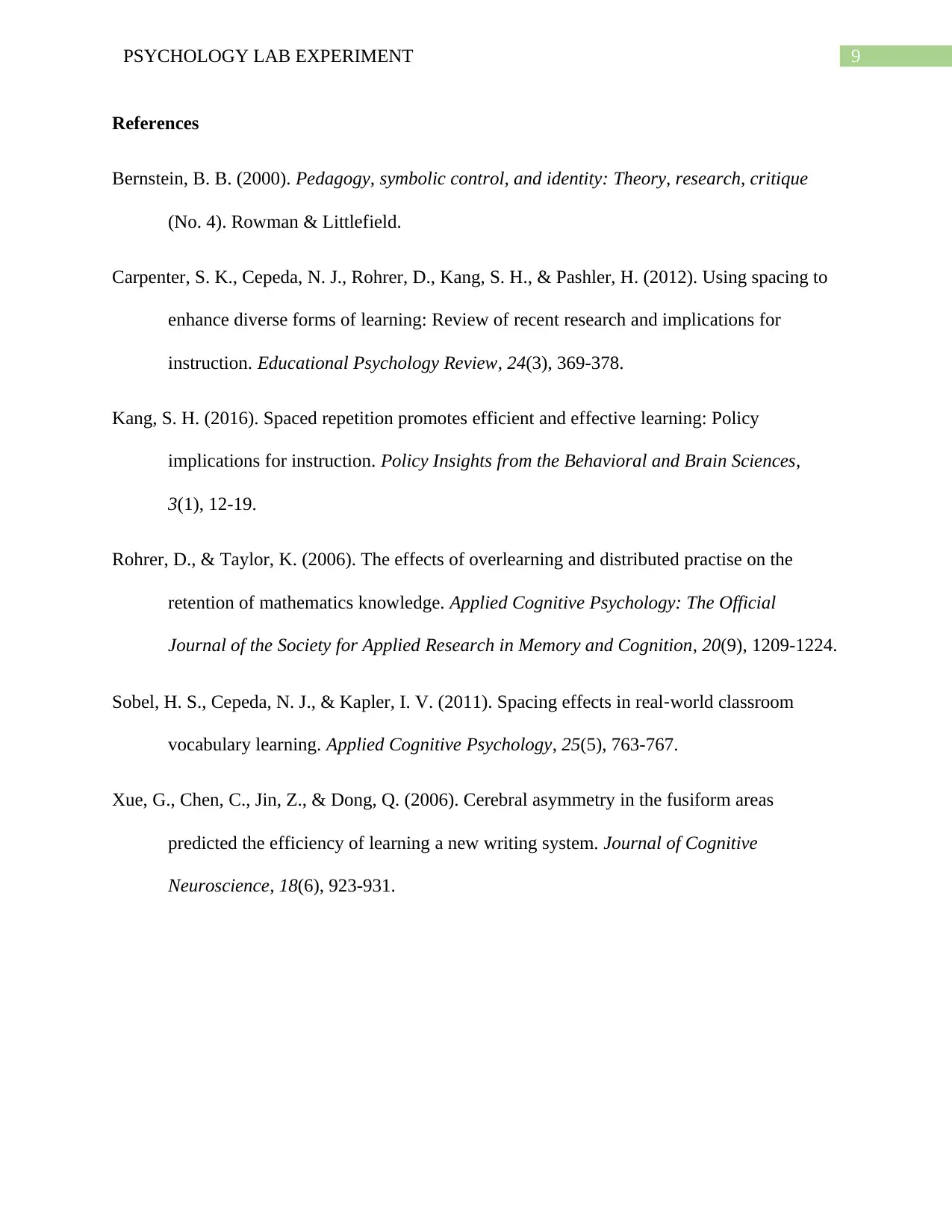
9PSYCHOLOGY LAB EXPERIMENT
References
Bernstein, B. B. (2000). Pedagogy, symbolic control, and identity: Theory, research, critique
(No. 4). Rowman & Littlefield.
Carpenter, S. K., Cepeda, N. J., Rohrer, D., Kang, S. H., & Pashler, H. (2012). Using spacing to
enhance diverse forms of learning: Review of recent research and implications for
instruction. Educational Psychology Review, 24(3), 369-378.
Kang, S. H. (2016). Spaced repetition promotes efficient and effective learning: Policy
implications for instruction. Policy Insights from the Behavioral and Brain Sciences,
3(1), 12-19.
Rohrer, D., & Taylor, K. (2006). The effects of overlearning and distributed practise on the
retention of mathematics knowledge. Applied Cognitive Psychology: The Official
Journal of the Society for Applied Research in Memory and Cognition, 20(9), 1209-1224.
Sobel, H. S., Cepeda, N. J., & Kapler, I. V. (2011). Spacing effects in real‐world classroom
vocabulary learning. Applied Cognitive Psychology, 25(5), 763-767.
Xue, G., Chen, C., Jin, Z., & Dong, Q. (2006). Cerebral asymmetry in the fusiform areas
predicted the efficiency of learning a new writing system. Journal of Cognitive
Neuroscience, 18(6), 923-931.
References
Bernstein, B. B. (2000). Pedagogy, symbolic control, and identity: Theory, research, critique
(No. 4). Rowman & Littlefield.
Carpenter, S. K., Cepeda, N. J., Rohrer, D., Kang, S. H., & Pashler, H. (2012). Using spacing to
enhance diverse forms of learning: Review of recent research and implications for
instruction. Educational Psychology Review, 24(3), 369-378.
Kang, S. H. (2016). Spaced repetition promotes efficient and effective learning: Policy
implications for instruction. Policy Insights from the Behavioral and Brain Sciences,
3(1), 12-19.
Rohrer, D., & Taylor, K. (2006). The effects of overlearning and distributed practise on the
retention of mathematics knowledge. Applied Cognitive Psychology: The Official
Journal of the Society for Applied Research in Memory and Cognition, 20(9), 1209-1224.
Sobel, H. S., Cepeda, N. J., & Kapler, I. V. (2011). Spacing effects in real‐world classroom
vocabulary learning. Applied Cognitive Psychology, 25(5), 763-767.
Xue, G., Chen, C., Jin, Z., & Dong, Q. (2006). Cerebral asymmetry in the fusiform areas
predicted the efficiency of learning a new writing system. Journal of Cognitive
Neuroscience, 18(6), 923-931.
1 out of 10
Your All-in-One AI-Powered Toolkit for Academic Success.
+13062052269
info@desklib.com
Available 24*7 on WhatsApp / Email
![[object Object]](/_next/static/media/star-bottom.7253800d.svg)
Unlock your academic potential
© 2024 | Zucol Services PVT LTD | All rights reserved.
